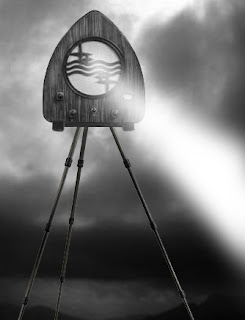-- Harold Taylor, 1939, from the Rhythm Magazine article, You Can Keep Raymond Scott
 In addition to making some of the most joyously intricate and distinctive melodies of the 20th Century, Raymond Scott was also a leading pioneer in multi-track recording, electronic music and collaborated with the likes of Robert Moog, Jim Henson and Motown. But odds are you will recognize his tunes from Warner Brothers cartoons. He is arguably one of the most influential musician/inventors in American music. Here is his signature song, "Powerhouse," as performed by the band Racalmuto.
In addition to making some of the most joyously intricate and distinctive melodies of the 20th Century, Raymond Scott was also a leading pioneer in multi-track recording, electronic music and collaborated with the likes of Robert Moog, Jim Henson and Motown. But odds are you will recognize his tunes from Warner Brothers cartoons. He is arguably one of the most influential musician/inventors in American music. Here is his signature song, "Powerhouse," as performed by the band Racalmuto.-- Paul D. Miller, a.k.a. Dj Spooky
Raymond's six-piece band was called the "Raymond Scott Quintette." (Apparently, Raymond thought the word "sextet" would distract from the music and the Frenchie "ette" lent a touch of class.) While the music was classified as jazz, jazz critics were frequently hostile. Despite the critics, the music proved highly popular with the buying public.
It was not so popular with the band members. Raymond coerced them into upwards of 60 takes, performing dizzying riffs -- and sometimes under weird acoustic circumstances in order to achieve a particular sound. Unlike other jazz acts, improvisation was not allowed. The songs are intricately assembled as though they were designed by an engineer. Band members could not deviate from the strict tune structure any more than parts manufacturers could deviate from an engine design. Raymond didn't use sheet music either. He recorded the players, edited the strips, played them back and asked the players to play the re-ordered arrangements from memory.
 "What can you say about a man who inspired cartoon melodies and bebop, invented Frank Zappa and electronic music, and still found time to work for Motown?"
"What can you say about a man who inspired cartoon melodies and bebop, invented Frank Zappa and electronic music, and still found time to work for Motown?"-- Andy Partridge, XTC
Here is the Raymond Scott Quintette performing War Dance for Wooden Indians. The image to the left is from a comic strip biography of Raymond Scott by Justin Green, available at the Official Raymond Scott site.
The 1940's saw a lot of changes for Raymond Scott. In 1941, he sold his compositions (finally rendered in musical notation) to Warner Brothers. The music was enthusiastically seized upon by Carl Stalling, the man who scored the Warner Brothers cartoons -- which is largely why these tunes are so embedded in our consciousness. (To this day, people think Raymond wrote for cartoons, but he never did. He never even watched cartoons.)
-- Leonard Maltin, film critic
In 1942, he became Music Director for CBS Radio and made history by hiring black musicians. His CBS band was the first racially integrated band for radio. In 1946, he founded Manhattan Research Inc, "the world's most extensive facility for the creation of Electronic Music and Musique Concrete." It was the first electronic music studio.
Raymond's brother Mark Warnow died in 1949 and Raymond took over Mark's job: Orchestra Leader for Your Hit Parade. Raymond Scott and his wife, Dorothy Collins, became early TV celebrities. Here is the Raymond Scott Quintette performing "Powerhouse" on Your Hit Parade. Raymond called it a "rent gig." In fact, he used his handsome salary to invest in electronic equipment. In the late 40's, along with Les Paul, Raymond started experimenting with a new recording technique called multi-track.
-- Mark Mothersbaugh, Devo
In 1949, Raymond said, "Perhaps within the next hundred years, science will perfect a process of thought transference from composer to listener. The composer will sit alone on the concert stage and merely think his idealized conception of his music. Instead of recordings of actual music sound, recordings will carry the brainwaves of the composer directly to the mind of the listener."
 By the mid-50's his studio began to look (according to friends such as Robert Moog) like a science fiction set. Over the years, Raymond invented numerous electronic musical instruments including the Clavivox and the Electronium.
By the mid-50's his studio began to look (according to friends such as Robert Moog) like a science fiction set. Over the years, Raymond invented numerous electronic musical instruments including the Clavivox and the Electronium.Robert Moog credits Raymond as an important influence on the invention of the Moog Synthesizer. In 1962 and 1963, Raymond released Soothing Sounds for Baby. It was entirely electronic music he composed as an "aural toy" for children. While it was a commercial failure at the time, some now regard it as a strong pre-cursor to ambient music (over a decade before Brian Eno's recordings).
Electronic music can suffer from an outdated sound very quickly. However, Raymond Scott's electronic music from the 60's still hold up today. In a 1962 lecture, Raymond said, "To say that we haven't scratched the surface in this field wouldn't be exactly right. Because every time we scratch we find the surface thicker and thicker and thicker. For the possibilities in electronic music are really quite infinite."
-- Henry Rollins, Black Flag, Rollins Band
In the early 70's, Raymond was hired by Barry Gordy to develop new electronic sounds when Motown was positioning itself as a leader in cutting-edge music. Today, we don't know the degree of influence Raymond had on the 70's Motown sound. (If you've seen "Standing in the Shadows of Motown" you know that the Motown star-machine, as policy, kept the support crew on the down-low.)
 One very unique collaboration was with an up-and-coming puppeteer. Raymond Scott and Jim Henson collaborated on "Limbo - The Organized Mind" a very unique performance which appeared on The Tonight Show with Johnny Carson.
One very unique collaboration was with an up-and-coming puppeteer. Raymond Scott and Jim Henson collaborated on "Limbo - The Organized Mind" a very unique performance which appeared on The Tonight Show with Johnny Carson.-- Bob Moog, inventor of Moog synthesizers
Scott fans include Igor Stravinsky, Henry Rollins, XTC, Elvis Costello, the Kronos Quartet, They Might Be Giants, Devo, Jascha Heifetz, Art Blakey and Danny Elfman. You can hear Scott's influence in Benny Goodman, bebop, ambient, electronica and The Simpsons theme. In 1986, Raymond composed his last known work, "Beautiful Little Butterfly," in Midi. In 1992, a retrospective of Raymond Scott's work, Reckless Nights and Turkish Twilights, brought Raymond Scott to a new audience. Raymond died in 1994.
Concordia University in Montreal recently hosted a Raymond Scott Centennial Tribute Concert:
 157 West 57th Street
157 West 57th StreetBoy Scout in Switzerland
Dinner Music for a Pack of Hungry Cannibals
A Message from Where
The Rhythm Modulator
Twilight in Turkey
War Dance for Wooden Indians
As more music lovers discover him, Raymond Scott is gradually becoming recognized as one of the great innovators in American music. September 10th of 2008, will be Scott's 100th birthday. For much more, here is the official Raymond Scott site, the Raymond Scott Blog and the Raymond Scott MySpace page.
-- David Harrington, Kronos Quartet
__________________________






























